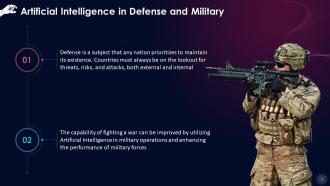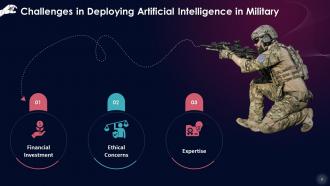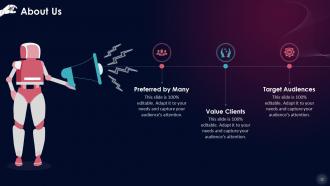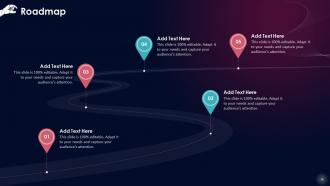AI Driven Defense And Military Training Ppt
These slides showcase the importance of AI in Defense and the Military. The AI applications in defense and military include surveillance, training, cybersecurity, arms and ammunition, and logistics.
These slides showcase the importance of AI in Defense and the Military. The AI applications in defense and military include..
- Google Slides is a new FREE Presentation software from Google.
- All our content is 100% compatible with Google Slides.
- Just download our designs, and upload them to Google Slides and they will work automatically.
- Amaze your audience with SlideTeam and Google Slides.
-
Want Changes to This PPT Slide? Check out our Presentation Design Services
- WideScreen Aspect ratio is becoming a very popular format. When you download this product, the downloaded ZIP will contain this product in both standard and widescreen format.
-

- Some older products that we have may only be in standard format, but they can easily be converted to widescreen.
- To do this, please open the SlideTeam product in Powerpoint, and go to
- Design ( On the top bar) -> Page Setup -> and select "On-screen Show (16:9)” in the drop down for "Slides Sized for".
- The slide or theme will change to widescreen, and all graphics will adjust automatically. You can similarly convert our content to any other desired screen aspect ratio.
Compatible With Google Slides

Get This In WideScreen
You must be logged in to download this presentation.
PowerPoint presentation slides
Presenting AI Driven Defense and Military. These slides are 100 percent made in PowerPoint and are compatible with all screen types and monitors. They also support Google Slides. Premium Customer Support available. Suitable for use by managers, employees, and organizations. These slides are easily customizable. You can edit the color, text, icon, and font size to suit your requirements.
People who downloaded this PowerPoint presentation also viewed the following :
Content of this Powerpoint Presentation
Slide 1
This slide showcases the importance of Artificial Intelligence in Defense and Military. Artificial Intelligence advancements will open up new possibilities in defense technologies. The capability of fighting a war can be improved by utilizing Artificial Intelligence in military operations and improving the performance of military forces.
Slide 2
This slide highlights that many countries across the world are using Artificial Intelligence to enhance their defense and military operations. Technologies such as Deep Learning machines, which require Big Data and artificial neural networks, are being used.
Instructor’s Notes:
Many countries across the world are using AI to improve the effectiveness of their defense forces in the following ways:
- With the extensive use of AI gadgets every operator in the defense network can be brought together to carry out and complete operations or assignments
- Unmanned and manned systems can be brought together for human and machine combat scenarios
Slide 3
This slide lists the advantages of Artificial Intelligence in defense and military operations. These benefits include better decision making, detection of mines underwater, deployment of military robots, better targeting, and unmanned vehicles & use of drones.
Instructor’s Notes:
- Better decision making: Artificial Intelligence can compile data from numerous sensors and satellites and draw judgments. This may also make it easier for defense personnel to make decisions on what measures to take
- Unmanned vehicles & use of drones: The number of unmanned vehicles, such as planes and combat tanks, will undoubtedly increase. This will allow officers to make choices more quickly, save money, and remove these expensive machines from risky situations. AI can help a drone take off and land without the need for human intervention, and it can even carry out the operation
- Better targeting potential: Some land-based combat vehicles employ AI and Machine Learning to improve targeting capabilities
- Deployment of military robots: Military robots with Artificial Intelligence can carry out operations or jobs on their own, saving precious human lives
Slide 4
This slide highlights applications of Artificial Intelligence in defense and military. These include surveillance, training, cybersecurity, arms & ammunition, and logistics.
Instructor’s Notes:
- Surveillance: AI paired with geospatial analysis can help extract valuable information from networked equipment like radars and automatic identification systems. Analysis of this data can reveal illegal or suspect activity and warn the proper authorities. IoT-enabled robots can also aid target detection and characterization with AI and computer vision
- Training: Training and simulation are two fields that use system and software engineering ideas to create models that can help soldiers train on combat systems used by real-world armed forces. The US Navy and Army have already started sensor simulation programs. Additionally, augmented and virtual reality (VR) technology can create effective, accurate, and dynamic training simulations
- Cybersecurity: Cyberspace is now viewed as the fourth front after land, sea, and air. A maliciously hacked network might put the entire region's security in jeopardy. Defense organizations are employing Machine Learning to predict and protect against illegal breaches.
- Arms & Ammunition: New-age weaponry now incorporates AI-enabled technology. Advanced missiles, for example, can estimate and assess target levels for kill zones without the involvement of humans
- Logistics: One of the factors in determining whether or not a military mission succeeds is logistics. Military logistic systems are combined with Machine Learning and geospatial analysis to reduce labor, time, and error
- Detection of underwater mines: Currently, ships equipped with sonar are widely employed to detect mines beneath the water. However, as AI advances, a submersible boat or vessel might be equipped with AI to identify mines. The time it takes to identify mines would be reduced, and it would examine the object, identify it, and take the appropriate decision
Slide 5
This slide showcases how different countries are using Artificial Intelligence in military operations. USA, China, and Russia are the first ones to use cutting-edge technology to strengthen their forces.
Instructor’s Notes:
- USA: The US Department of Defense unveiled its first AI plan in 2019, asking for expanded use of AI systems across the army, from decision-making to problem forecasting, through investment and engagement with private AI research organizations
- China: The Chinese government has also pushed for more AI and Machine Learning-based military technology development.They have advocated for "military-civil fusion-style innovation" incorporated into China's national strategy. China's State Council AI Plan outlines the country's ambitious plan to establish a 150 billion RMB AI industry, was released in 2017
- Russia: The military capability of Russia is well-known throughout the world. High-ranking army officials have been seen supporting the development of AI-based technology. According to sources, Russian defense forces are mulling the use of Artificial Intelligence, Big Data, and Machine Learning to conduct more effective intelligence operations. In both the military and commercial sectors, Russia is heavily investing in Artificial Intelligence (AI) for the detection, analysis, and refutation of misinformation
Slide 6
This slide talks about the AI powered drones used by the Turkish military for use in the defense sector. Turkey's drones are one of the most potent symbols of the country's air might as they can neutralize enemy targets in high-risk warfares.
Instructor’s Notes: Kargu-2, Alpagu, Togan, and Simsek are four types of autonomous drones that have been deployed in the Turkish defense sector. These kamikaze-style drones can perform intelligence gathering, surveillance, target acquisition, and reconnaissance tasks in addition to attacking. They can attack targets in places where the operator and the warhead don't have access to mobile data or the Internet.
Slide 7
This slide discusses the use of Artificial Intelligence in Israel’s Iron Dome. Israel's Iron Dome was developed by Rafael Advanced Defense Systems and Israel Aerospace Industries to detect, intercept, and destroy rockets and 155mm artillery shells fired from a range of between 2.5 miles and 43 miles.
Instructor’s Notes: According to reports, the AI-powered anti-missile system is 90% successful. The Iron Dome radar tracks the missile route after detecting and identifying an external rocket, and the Battle Management and Control (BMC) estimates the potential place of impact based on that information. If the AI system detects a credible threat, it orders the dome to fire an interceptor or a quicker missile at the threat, blowing off the enemy missile at a high altitude or over a neutral area.
Slide 8
This slide depicts the challenges associated with the deployment of Artificial Intelligence in defense and military. These challenges include financial investment, expertise, and ethical concerns.
Instructor’s Notes:
- Expertise: Investing a significant amount in a panel of experts to discuss the future of military strength and share views on how Artificial Intelligence and Machine Learning will affect national security is necessary yet tough, particularly for middle-income countries
- Financial Investment: The financial investment required to adopt AI-based technology is one of the key hurdles. How much we can afford to invest in infrastructure to support the development of such technologies is a significant question, especially in middle-income countries. One possible solution is for governments to identify and pursue AI initiatives that are critical to national security
- Ethical Concerns: The use of AI in defense creates ethical considerations. Such technologies have been developed by experts and organizations worldwide, thereby creating tensions between governments. One of the arguments is that if an AI system fails to operate as intended, the results could be severe. Several human and civil rights organizations have asked for a complete ban on autonomous defensive techniques, including weapons
AI Driven Defense And Military Training Ppt with all 24 slides:
Use our AI Driven Defense And Military Training Ppt to effectively help you save your valuable time. They are readymade to fit into any presentation structure.
-
Love how there are no boring templates here! The design is fresh and creative, just the way I like it. Can't wait to edit and use them for my extended projects!
-
I am not the best at presentations but using SlideTeam’s PPT template made it easier for me. Thank you SlideTeam!























































